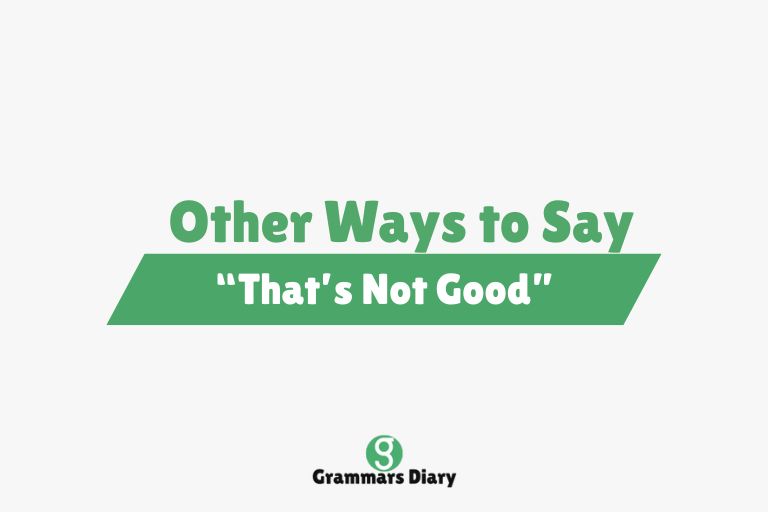The phrase “that’s not good” is something we often say when something goes wrong, feels disappointing, or falls short of our expectations, whether we’re reacting to bad news, poor performance, a mistake, or just something unpleasant in general.
While it works well in casual conversation, having a broader vocabulary to express dissatisfaction, disapproval, or concern can help you better articulate your thoughts depending on the tone, context, and level of formality needed, and this can be especially helpful in professional environments, writing, or when trying to be more precise or empathetic.
This article explores a wide range of expressions—some softer, some more direct, some formal and others casual—that can be used in place of “that’s not good,” giving you more tools to clearly and thoughtfully convey your concerns or reactions in any situation.
Other Ways to Say “That’s Not Good”
1. That’s unfortunate
Example: “It’s unfortunate that the delivery got delayed again.”
Meaning: Expresses regret or mild disappointment about a situation without assigning blame or sounding overly critical.
Usage: Ideal for polite, diplomatic communication in both personal and professional settings.
2. That’s a problem
Example: “If we don’t meet the deadline, that’s a problem for the client.”
Meaning: Indicates that the issue could have consequences or needs immediate attention.
Usage: Common in work environments where clear identification of challenges is needed.
3. That’s disappointing
Example: “It’s disappointing to hear that the test results weren’t as expected.”
Meaning: Highlights emotional letdown or unmet expectations without being too harsh.
Usage: Appropriate when providing feedback or reacting to news that doesn’t meet hopes or standards.
4. That’s troubling
Example: “It’s troubling that multiple reports flagged the same security issue.”
Meaning: Suggests concern or unease, often used in serious or concerning situations.
Usage: Useful in professional or formal settings to raise red flags or concerns.
5. That’s not ideal
Example: “Having only one person manage three teams is not ideal.”
Meaning: Implies that a better alternative exists without being overly negative.
Usage: Frequently used in business or feedback conversations to gently critique a situation.
6. That’s a setback
Example: “Losing our lead engineer is definitely a setback.”
Meaning: Acknowledges a delay or hindrance in progress without completely condemning the situation.
Usage: Common in project discussions or evaluations.
7. That’s unfortunate timing
Example: “Getting sick right before your vacation is unfortunate timing.”
Meaning: Highlights the bad luck or inconvenience of an event’s timing.
Usage: Good for casual conversations or expressing empathy.
8. That’s regrettable
Example: “It’s regrettable that the partnership didn’t work out.”
Meaning: A formal or polite way of expressing disappointment or remorse.
Usage: Suitable for diplomatic communication or sensitive discussions.
9. That’s not acceptable
Example: “Deliberately missing deadlines is not acceptable.”
Meaning: Shows firm disapproval, especially in rules-based or professional contexts.
Usage: Often used when discussing standards, rules, or consequences.
10. That’s less than ideal
Example: “The new system is slower than the old one, which is less than ideal.”
Meaning: Offers criticism in a subtle or indirect way.
Usage: Works well in professional conversations that require tact.
11. That’s concerning
Example: “It’s concerning that the same issue keeps happening.”
Meaning: Suggests worry or the need for deeper investigation.
Usage: Common in professional or safety-related contexts.
12. That’s not great
Example: “He missed three meetings this week—that’s not great.”
Meaning: Understated way of expressing disapproval or concern.
Usage: Frequently used in casual or light critiques.
13. That’s poor
Example: “The quality of the presentation was poor.”
Meaning: Indicates a substandard outcome, often tied to measurable performance.
Usage: Suitable in reviews, assessments, or critiques.
14. That’s below expectations
Example: “The sales numbers this quarter were below expectations.”
Meaning: Highlights that performance or results did not meet goals.
Usage: Used frequently in business reports or evaluations.
15. That’s unhelpful
Example: “Your vague instructions were unhelpful.”
Meaning: Directly criticizes something that failed to assist or clarify.
Usage: Useful in constructive feedback.
16. That’s a red flag
Example: “Their lack of transparency is a red flag.”
Meaning: Indicates a warning sign or early indication of a bigger problem.
Usage: Common in analysis or decision-making contexts.
17. That’s questionable
Example: “Approving that decision without data is questionable.”
Meaning: Casts doubt on the validity, ethics, or logic of something.
Usage: Effective in discussions involving judgment or reasoning.
18. That’s not looking good
Example: “The weather report for the wedding day is not looking good.”
Meaning: Suggests that current conditions or predictions indicate a negative outcome.
Usage: Common in casual or forecasting contexts.
19. That’s unfortunate news
Example: “That’s unfortunate news about the budget cuts.”
Meaning: Softens the blow when reacting to bad or unwanted updates.
Usage: Often used when trying to be empathetic or diplomatic.
20. That’s not reassuring
Example: “Your vague response is not reassuring.”
Meaning: Indicates that something fails to provide comfort or confidence.
Usage: Useful in situations where clarity and reliability are expected.
21. That’s unsatisfactory
Example: “The explanation given was unsatisfactory.”
Meaning: Implies that something does not meet basic standards or expectations.
Usage: Common in evaluations or feedback reports.
22. That’s worrisome
Example: “Their delay in responding is worrisome.”
Meaning: Expresses growing concern or alarm.
Usage: Often found in discussions involving risk, safety, or emotional wellbeing.
23. That’s inefficient
Example: “This process is unnecessarily complicated and inefficient.”
Meaning: Critiques the lack of effectiveness or productivity.
Usage: Useful in operational reviews or process evaluations.
24. That’s not up to par
Example: “His recent performance is not up to par.”
Meaning: Suggests something doesn’t meet expected standards or norms.
Usage: Frequently used in reviews or assessments.
25. That’s unacceptable behavior
Example: “Interrupting the speaker repeatedly was unacceptable behavior.”
Meaning: Clearly states disapproval, especially of actions or conduct.
Usage: Strong language often used in formal reprimands or disciplinary contexts.
When to Use Different “That’s Not Good” Alternatives
In Professional Settings
In workplace settings, word choice can influence how feedback or concerns are received, so using terms like “unsatisfactory,” “inefficient,” “not acceptable,” or “below expectations” allows you to be precise without sounding overly emotional, and it gives your communication a level of formality that helps maintain professionalism while addressing important issues.
In Casual Conversations
In daily life or informal chats, softer or more conversational alternatives like “that’s not great,” “that’s unfortunate,” or “that’s a bummer” are more natural and relatable, and they help you convey empathy or mild disappointment without coming across as too harsh or dramatic.
In Sensitive or Emotional Contexts
When emotions are involved, or when you’re trying to be compassionate or diplomatic, choosing phrases like “that’s troubling,” “that’s unfortunate news,” or “that’s concerning” can show that you care and that you’re mindful of the emotional impact of the situation, which is especially important in personal relationships or emotionally charged discussions.
Conclusion
While “that’s not good” is a perfectly acceptable expression in everyday English, expanding your vocabulary with these 25 alternatives allows you to be more specific, diplomatic, or emotionally attuned, depending on the context—whether you’re offering feedback, reacting to bad news, or simply expressing concern.
Language is powerful, and having the right phrase ready can help you communicate with clarity, empathy, and professionalism across a wide range of situations, making your conversations more effective and thoughtful.
FAQs
What does “that’s not good” mean?
It’s a general phrase used to express disapproval, concern, disappointment, or recognition that something has gone wrong or isn’t acceptable.
Is “that’s not good” formal?
No, it’s more informal and conversational; in formal or professional contexts, it’s often better to use specific alternatives like “unsatisfactory” or “not acceptable.”
Can I use these alternatives interchangeably?
Not all of them—some expressions are softer or more casual, while others are formal or context-specific, so it’s important to match your choice of words to your tone and audience.











